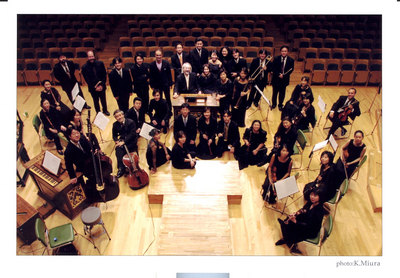Bach Collegium Japan to perform 'very special' Mass in B minor at Hill Auditorium

The Bach Collegium Japan comes to Ann Arbor on March 24.
When Masaaki Suzuki, artistic director and music director of the Bach Collegium Japan, describes J.S. Bach’s Mass in B minor as “exceptional,” he is evoking the word’s root meaning as well as the notion of extraordinary quality.
“All his other vocal works, including the St. Matthew and St. John passions, were part of his daily job.
"The Mass in B minor is the real exception. You can never compare it with the other works. In this way it is very special.”
Special and also “the favorite for me,” he added in a recent phone conversation from his home in Tokyo.
Thursday, Suzuki and the choir and instrumentalists of the Bach Collegium Japan bring this exceptional work to Hill Auditorium, returning to Ann Arbor for the first time since 2003, when they performed the Bach “St. Matthew Passion” at St. Francis of Assisi Catholic Church.
PREVIEW
The Bach Collegium Japan
- Who: Masaaki Suzuki, artistic director and conductor.
- What: J.S. Bach, Mass in B minor.
- Where: Hill Auditorium, 825 N. University Ave.
- When: Thursday, March 24, 8 p.m.
- How much: $10-$65. Some proceeds go to relief efforts for the earthquake and tsunami in Japan. UMS Ticket Office in the Michigan League, (734) 764-2538, and online at ums.org.
Bach compiled the Mass in B minor at the end of his life, in 1749 (he died in 1750), and he included in it music he had composed as much as 30 years earlier. It is not thought to be composed for a specific occasion nor was it performed, in full, in Bach’s lifetime. In fact, full performances would wait until the 19th century. It is a full mass — unusual for composers in the Lutheran tradition — and not unlike Bach’s “The Art of the Fugue,” it holds sway not only as one of the masterworks of Western music but as a grand summation — in this case of the composer’s thoughts on sacred vocal music.
Performances of the mass, when it was taken up again in the 19th century, doubtless included larger forces than the ones the Bach Collegium deploys: These days, small is beautiful, in line with current thought on authentic performance practice. But Suzuki does not go along with musicologist Joshua Rifkin’s one-voice-to-a-part distribution.
“We’ve experimented with several sizes of choir,” he said. “Now we usually use 18 singers, and when we divide for double choir, that number makes for the least difference between movements. Nowadays, modern concert halls need more than one singer to a part, but at the same time it’s hard to keep a balance.
“Also, even thought I usually ask the soloists to sing in the choir, it’s a good idea to keep them away here,” because of the difficulty of some of the solo singing they must do.
Renowned for its performances and recordings of Bach’s cantatas, the Bach Collegium Japan, founded in 1990, only took up the mass in 2000.
“Up to then we had never performed this work,” said Suzuki. “Since then, we have performed it quite many times.” The group also released a highly regarded recording of the mass in 2007, with some of the same soloists — soprano Rachel Nicholls, tenor Gerd Turk and bass Peter Kooij — who appear here in Ann Arbor. (The other Ann Arbor soloists are soprano Hana Blazikova and countertenor Clint van der Linde.)
Asked if his interpretation of the work has changed over the years, Suzuki responded, with a laugh, that “nothing has really changed, except we are getting older and older.”
But, he added, “the only thing has been that the choir members are changing all the time; it has only been since five or six years that it has been stable.”
To Suzuki, the history of the mass — that is to say, its compilation at the end of Bach’s life, and its incorporation of earlier material — cannot be heard in performance.
“The work is so well integrated,” he said, “it is hardly possible to hear any trace of how it was made. The whole entire work we can appreciate as one being.”
He acknowledges, though, that at the end of the “Gloria,” “we all feel kind of the end of the piece, the climax.” And the “Gloria,” he said, is his favorite part, if he had to pick.
Some choirs perform the piece just up to the “Gloria.” But though Suzuki places an intermission after it, his group sings through to the actual end.
What follows the “Gloria,” is “more complicated and more polyphonic,” he said.
“It’s quite hard to keep the tension in the concert situation, but it is really a great joy to perform those movements. I much more prefer to do everything as an entire work.”
Note: The University Musical Society has announced it will donate 50 percent of the proceeds of every ticket sold to the concert between now and March 24 to the American Red Cross Japan Earthquake and Pacific Tsunami Relief Fund, an organization designated by the Bach Collegium Japan.

